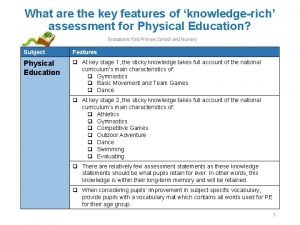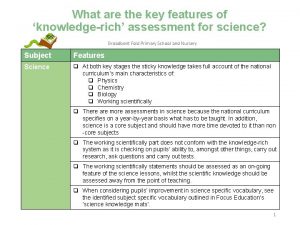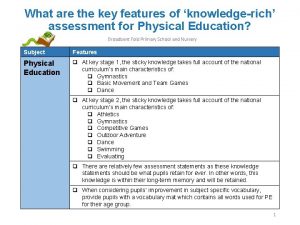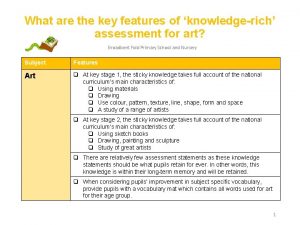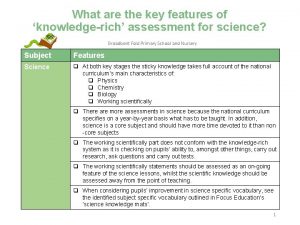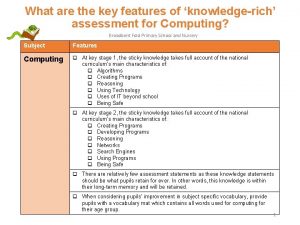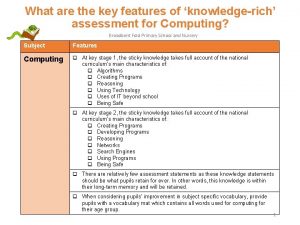What are the key features of knowledgerich assessment









- Slides: 9

What are the key features of ‘knowledge-rich’ assessment for history? Broadbent Fold Primary School and Nursery Subject Features History q At key stage 2, the sticky knowledge takes full account of the national curriculum’s main characteristics of: q Chronology, from the stone age to 1066 q One study beyond 1066 q Ancient civilizations q Civilizations around 900 AD q Ancient Greece q There are relatively few assessment statements as these knowledge statements should be what pupils retain for ever. In other words, this knowledge is within their long-term memory and will be retained. q There is a difference between knowledge which will be retained close to the point of teaching and that which will be retained for ever. q In effect, sticky knowledge refers to the long-term memory and should not be assessed too close to the point of teaching. q When considering pupils’ improvement in subject specific vocabulary, see the identified historical specific vocabulary outlined in Focus Education’s ‘historical knowledge mats’. 1

History: Key Stage 1 Within living memory Beyond living memory • changes within living memory. Where appropriate, these should be used to reveal aspects of change in national life • events beyond living memory that are significant nationally or globally [for example, the Great Fire of London, the first aeroplane flight or events commemorated through festivals or anniversaries] Year 1 • Know that the toys their grandparents played with were different to their own • Organise a number of artefacts by age • Know what a number of older objects were used for • Know the main differences between their school days and that of their grandparents Year 2 • Know about an event or events that happened long ago, even before their grandparents were born • Know what we use today instead of a number of older given artefacts • Know that children’s lives today are different to those of children a long time ago Lives of significant people Local history • the lives of significant individuals in the past who have contributed to national and international achievements. Some should be used to compare aspects of life in different periods • significant historical events, people and places in their own locality • Name a famous person from the past and explain why they are famous • Know the name of a famous person, or a famous place, close to where they live • Know about a famous person from outside the UK and explain why they are famous • Know how the local area is different to the way it used to be a long time ago • Differentiate between things that were here 100 years ago and things that were not (including buildings, tools, toys, etc. 2

History: Key Stage 2 CHRONOLOGY (Stone age to 1066) • • • Beyond 1066 LOCAL STUDY • An aspect of theme that takes pupils beyond 1066 • A local study linked to one of the periods of time studied under chronology; or • A local study that could extend beyond 1066 • Know how Britain changed between the beginning of the stone age and the iron age • Know the main differences between the stone, bronze and iron ages • Know what is meant by ‘huntergatherers’ • Know a significant time in history – WW 2 • Know this as a significant turning point in British History • Local Study related to WW 2 - For example: The Air Raid Shelters in Stockport. • Know how people lived and survived in WW 2. • Know significant events during WW 2 in Manchester. • Know how Britain changed from the iron age to the end of the Roman occupation • Know how the Roman occupation of Britain helped to advance British society • Know how there was resistance to the Roman occupation and know about Boudica • Know about at least one famous Roman emperor • Know a significant time in history- The Tudors • Know about the changing power of Monarchs using case studies such as: Henry VII, Henry VIII, Elizabeth • Local Study related to The Tudors- For example: Chester/ Bramall Hall/ Ordsall Hall • Know how people lived in the local area during The Tudor times. • Know about evidence from the past and how it shaped our future. To include: Stone age to Iron age Romans Anglo-Saxons Vikings Year 3 Year 4 3

History: Key Stage 2 ANCIENTS (approx. 3000 years ago) • Cover each of and then choose one to look at in depth: • Ancient Egypt • Ancient Sumer • Indus Valley • Shang Dynasty CIVILIZATIONS from 1000 years ago • • Choose one of: Mayans Islamic Civilizations Benin Civilization ANCIENT GREECE • Greek life and influence on the Western world Year 3 • Know some of the main characteristics of the Athenians and the Spartans • Know about the influence the gods had on Ancient Greece • Know at least five sports from the Ancient Greek Olympics Year 4 • Know about, and name, some of the advanced societies that were in the world around 3000 years ago • Know about the key features of either: Ancient Egypt; Ancient Sumer; Indus Valley; or the Shang Dynasty 4

History: Key Stage 2 CHRONOLOGY (Stone age to 1066) • • • Beyond 1066 LOCAL STUDY • An aspect of theme that takes pupils beyond 1066 • A local study linked to one of the periods of time studied under chronology; or • A local study that could extend beyond 1066 • Know how Britain changed between the end of the Roman occupation and 1066 • Know about how the Anglo. Saxons attempted to bring about law and order into the country • Know that during the Anglo. Saxon period Britain was divided into many kingdoms • Know that the way the kingdoms were divided led to the creation of some of our county boundaries today • Use a time line to show when the Anglo-Saxons were in England • Know a significant turning point in history. The Victorians and the significance of invention. • Know changes in aspects of social history, such as crime and punishment, leisure, entertainment in the 20 th • Know about a period of history that has strong connections to their locality and understand the issues associated with the period. • Know how the lives of wealthy people were different from the lives of poorer people during this time • Local study related to The Victorians- for example: Styal Mill • Know where the Vikings originated from and show this on a map • Know that the Vikings and Anglo. Saxons were often in conflict • Know why the Vikings frequently won battles with the Anglo. Saxons • Know about a theme in British history which extends beyond 1066 and explain why this was important in relation to British history • Know how to place historical events and people from the past societies and periods in a chronological framework • know how Britain has had a major influence on the world To include: Stone age to Iron age Romans Anglo-Saxons Vikings Year 5 Year 6 5

History: Key Stage 2 ANCIENTS (approx. 3000 years ago) • Cover each of and then choose one to look at in depth: • Ancient Egypt • Ancient Sumer • Indus Valley • Shang Dynasty CIVILIZATIONS from 1000 years ago • • Choose one of: Mayans Islamic Civilizations Benin Civilization ANCIENT GREECE • Greek life and influence on the Western world Year 5 Year 6 • Know about the impact that one of the following ancient societies had on the world: the Mayan civilization; the Islamic civilization; or the Benin • Know why they were considered an advanced society in relation to that period of time in Europe 6

Sticky Knowledge: History Year 1 Year 2 q Know that the toys their grandparents played with were different to their own q Know about an event or events that happened long ago, even before their grandparents were born q Organise a number of artefacts by age q Know what we use today instead of a number of older given artefacts q Know what a number of older objects were used for q Know about a famous person from outside the UK and explain why they are famous q Know the main differences between their school days and that of their grandparents q Know that children’s lives today are different to those of children a long time ago q Name a famous person from the past and explain why they are famous q Know how the local area is different to the way it used to be a long time ago q Know the name of a famous person, or a famous place, close to where they live q Differentiate between things that were here 100 years ago and things that were not (including buildings, tools, toys, etc. 7

Sticky Knowledge: History Year 3 Year 4 q Know how Britain changed between the beginning of the stone age and the iron age q Know how Britain changed from the iron age to the end of the Roman occupation q Know the main differences between the stone, bronze and iron ages q Know how the Roman occupation of Britain helped to advance British society q Know what is meant by ‘hunter-gatherers q Know how there was resistance to the Roman occupation and know about Boudica q Know some of the main characteristics of the Athenians and the Spartans q Know about at least one famous Roman emperor q Know about the influence the Gods had on Ancient Greece q Know about, and name, some of the advanced societies that were in the world about 3000 years ago q Know at least five sports competed in the Ancient Greek Olympics q Know about the key features of either: Ancient Egypt; Ancient Sumer; Indus Valley; or, the Shang Dynasty 8

Sticky Knowledge: History Year 5 Year 6 q Know how Britain changed between the end of the Roman occupation and 1066 q Know about the impact that one of the following ancient societies had on the world: the Mayan civilization; the Islamic civilization; or, the Benin q Know about how the Anglo-Saxons attempted to bring about law and order into the country q Know where the Vikings originated from and show this on a map q Know that during the Anglo-Saxon period Britain was divided into many kingdoms q Know that the Vikings and Anglo-Saxons were often in conflict q Know that the way the kingdoms were divided led to the creation of some of our county boundaries today q Know why the Vikings frequently won battles with the Anglo-Saxons q Know how the lives of wealthy people were different from the lives of poorer people q Know how to place features of historical events and people from the past societies and periods in a chronological framework q Use a time line to show when the Anglo. Saxons were in England q know how Britain has had a major influence on the world 9










